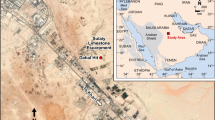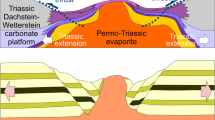Abstract
The Jurassic–Lower Cretaceous successions cropping out in three different parts of Central Anatolia (Turkey) were deposited in local basins developed under tectonic influence from the Hettangian to the Oxfordian. Pelagic carbonate platforms (PCPs) were formed in the region during two separate phases in which synsedimentary faulting was active in the basins. Prior to the first tectonic phase, fluvial and tidal sediments, Hettangian-Sinemurian in age, were deposited unconformably on the low-grade metamorphic substrate of the Karakaya Complex (Upper Triassic), with Sinemurian crinoidal limestones above. At the end of the Sinemurian, the PCPs were developed as a result of fragmentation of shallow-marine platforms by normal faults. Across hanging-wall basins and footwall-blocks, the PCP facies: pelagic/hemipelagic nodular and marly Ammonitico Rosso facies, brachiopod-bearing limestone facies with hardgrounds, red fossiliferous mudstone, and calcareous Ammonitico Rosso facies containing blocks, were deposited with marked lateral thickness variations. The platform, which gradually became shallower in relation to the clastic sediments (180 m thick) filling the basin, was fragmented again at the end of the Bathonian. The opening of fractures in the platform is documented by neptunian dykes developed within the clastic facies, filled with Callovian ammonite-bearing mudstone. During the Callovian–Oxfordian, widespread ammonite-bearing red marl draped the clastic facies, although nodular pelagic and oolitic/ammonite limestones are locally present. Moreover, Oxfordian pelagic oolitic facies rest unconformably on Upper Triassic sandstone (Karakaya complex), which is locally intercalated between the metamorphics and the Jurassic cover, wherever these had been unroofed at the footwall of Jurassic normal faults. As a result of the tectonic activity during the Callovian–Oxfordian time, the Ankara region totally became a PCP in the Oxfordian. Condensed, nodular, pelagic oolitic–ammonitic limestones were deposited across the major uplifted blocks in an open-marine environment, previously called the Ankara seamount. These facies constitute an important key level in the Ankara region. Laterally continuous deep-marine sediments overlying the Late Oxfordian–Early Cretaceous PCP deposits indicate the rapid foundering of this sector.













Similar content being viewed by others
References
Alkaya F (1991) Hasanoğlan (Ankara) yöresi Sinemuriyen-Alt Pliyensbahiyen Ammonit zonları ve Taphonomisi. Ahmet Acar Geology Symp Book of Abstract 11–21 (In Turkish with English abstract)
Alkaya F (1998) Ammonite fauna and stratigraphy of the Sinemurian and Bajocian (Lower-Middle Jurassic) succession of the Kösrelik-Kızık (Ankara) region. In the 75th year of the Republic of Turkey, Cong. Earth Sci. and Mining, Book of Abstract 137–138 (In Turkish with English abstract)
Alkaya F, Deli A (1998) Sinemurian and Toarcian (Lower Jurassic) succession of Alacaatlı Beytepe (Ankara) Region. In the 75th year of the Republic of Turkey. Firat Univ 156. 20years Symp., Book of Abstract (In Turkish with English abstract)
Altiner D, Koçyiğit A, Farinacci A, Nicosia U, Conti MA (1991) Jurassic-Lower Cretaceous stratigraphy and paleogeographic evolution of the southern part of North-Western Anatolia (Turkey). Geol Romana 27:13–80
Altınlı İE (1965) İnegöl havzasının jeolojisi ve hidrojeolojik incelemesi. İ.Ü. Fen Fak. Mecmuasi B 28:3–4 (In Turkish with English abstract)
Alvarez W (1989) Evolution of the monte nerone seamount in the umbria-marche apennines. Ital J Jeosci 108:23–39
Batman B, Kulaksiz S, Görmüş S (1978) Deformation features of Jurassic-Cretaceous succession in Alacaatli region (SW Ankara). Hacettepe Univ Earth Sci 4:135–153
Bice DM, Stewart KG (1990) The formation of isolated carbonate seamounts: tectonic and ecological controls in the northern Apennines. Special publ Int Ass Sediment 9:145–168
Bragin NY, Tekin UK (1999) Stratigraphy and the Upper Jurassic-Lower Cretaceous radiolarians from the carbonate-siliceous deposits, Ankara region. Turkey Stratigr Geol Correl 7(2):130–140
Cecca F, Fourcade E, Azema J (1992) The disapparence of the ‘‘Ammonitico Rosso”. Palaeogeogr Palaeocl 99(1–2):55–70
Clari PA, Martire L (1996) Interplay of cementation, mechanical compaction, and chemical compaction in nodular limestone of the Rosso Ammonitico Veronese (Middle-Upper Jurassic, north-eastern Italy). J Sediment Res 66:447–458
Cope JCW (1991) Ammonite faunas of the Ammonitico Rosso of the Pontide mountains, Northern Anatolia, Turkey. Geol Romana 27:303–325
Črne AE, Šmuc A, Skaberne D (2007) Jurassic neptunian dykes at Mt Mangart (Julian Alps, NW Slovenia). Facies 53:249–265
Decarlis A, Lualdi A (2011) Synrift sedimentation on the northern Tethys margin: an example from the Ligurian Alps (Upper Triassic to Lower Cretaceous, Prepiedmont domain, Italy). Int J Earth Sci 100:1589–1604
Deli A (2005) Beytepe Köyü- Alacaatlı-Etimesgut (GB Ankara) yöresinde Jura-Kretase çökellerin sedimantolojik özellikleri. Selçuk Üniv. Fen Bil. Enst. PhD Thesis. p 226 (In Turkish with English abstract)
Deli A, Orhan H (2007) Stratigraphy of Jurassic-Cretaceous aged deposits outcropping around Alacaatli-Beytepe village (South West Ankara). Selcuk Univ J Engin Sci Tech 22:60–78 (In Turkish with English abstract)
Deli A, Orhan H (2010) Synsedimentary structures in Jurassic rocks at South-West of Ankara (TURKEY). Proceedings of the In. Symp. Geol. of Natural Systems-Geo Iași Book of Abstract 229–232
Delikan A, Atasagün N (2018) Facies characteristics of Jurassic-Lower Cretaceous successions at Kosrelik-Kosrelikizigi (North of Ankara, Turkey). Carbonate Evaporite 33:375–402
Delikan A, Hatipoğlu T (2019) Hasanoğlan (KD-Ankara-Türkiye) bölgesinin Jura-Erken Kretase yaşlı çökellerinin sedimantolojik ve litofasiyes özellikleri. Selcuk Univ J Eng Sci Tech 7(2):448–466 (In Turkish with English abstract)
Duke WL, Arnott RWC, Cheel RJ (1991) Shelf sandstones and hummocky cross-stratification: new insights on a stormy debate. Geology 19:625–628
Dunham RJ (1962) Classification of carbonate rocks according to depositional textures. In: Ham WE (eds) Classification of carbonate rocks. Am Assoc Petr Geol M 1:108–121
Elmi S (1981) Classification typologique et genetique des Ammonitico-Rosso et des facies noduleux ou grumeleux: essai de synthese. In: Farrinacci A, Elmi S (eds), Rosso Ammonitico Symposium Proceedings. Tecnoscienza 233–249.
Eyuboglu Y, Bektaş O, Seren A, Maden N, Jacoby WR, Özer R (2006) Three axial extensional deformation and formation of the Liassic rift basins in the Eastern Pontides (NE Turkey). Geol Carpath 57(5):337–346
Eyuboglu Y (2015) Petrogenesis and U-Pb zircon chronology of felsic tuffs interbedded with turbidites (Eastern Pontides Orogenic Belt, NE Turkey): implications for Mesozoic geodynamic evolution of the eastern Mediterranean region and accumulation rates of turbidite successions. Lithos 212–215:74–92
Eyuboglu Y, Dudas FO, Santosh M, Xiao Y, Yi K, Chatterjee N, Wu FY, Bektaş O (2016) Where are the remnants of a Jurassic ocean in the eastern Mediterranean region. Gondwana Res 33:63–91
Flügel E (2004) Microfacies of carbonate rocks. Analysis, interpretation and application. Springer, Berlin Heidelberg, p 976
Elmi S (1981) Preface. In: Farinacci A, Elmi S (eds) Rosso Ammonitico Symposium Proceedings, Tecnoscienza, 1-8
Higgs R (1990) Sedimentology and tectonic implications of Cretaceous fan-delta conglomerates, Queen Charlotte Islands, Canada. Sedimentology 37:83–103
Higgs R (2011) Hummocky cross-stratification-like structures in deep-sea turbidites: Upper Cretaceous Basque basins (Western Pyrenees, France)’ by Mulder et al. (2009), Sedimentology, 56, 997–1015 Discussion. Sedimentology 58: 566-570
Jach R (2005) Storm-dominated deposition of the Lower Jurassic crinoidal limestones in the Krizna unit, Western Tatra Mountains, Poland. Facies 50:561–572
Jenkyns HC (1971) The genesis of condensed successions in the Tethyan Jurassic. Lethaia 4:327–352
Jenkyns HC (1972) Pelagic «oolites» from the Tethyan Jurassic. Jour Geology 80:21–33
Jenkyns HC (1974) Origin of red nodular limestone (Ammonitico Rosso, Knollenkalke) in the Mediterranean Jurassic: a diagenetic model. Int As Sed 1:249–271
Jenkyns HC (1986) Pelagic environment, in H.G. Reading, ed., Sedimentary environment and Facies. 2nd.: Oxford Black-well Sci Publ 343–398
Kandemir R, Yilmaz C (2009) Lithostratigraphy, facies, and deposition environment of the Lower Jurassic Ammonitico Rosso type sediments (ARTS) in the Gümüshane area, NE Turkey: implications for the opening of the northern branch of the Neo-Tethys Ocean. J Asian Earth Sci 34:586–598
Kirmaci MZ (2000) Lithofacies features and evolution of the Late Jurassic carbonate platform, Uluçayır area (Bayburt, Eastern Pontides). Geological Bulletin of Turkey 43–2:33–47
Koçyiğit A (1991) First remarks on the geology of the Karakaya Basin: Karakaya Orogen and Pre-Jurassic Nappes in Eastern Pontids, Turkey. Geol Romana 27:3–11
Koçyiğit A, Altiner D (2002) Tectonostratigraphic evolution of the North Anatolian Paleorift (NAPR): Hettangian-Aptian passive continental margin of the Northern Neo-Tethys. Turk J Earth Sci 11:169–191
Kuznetsova KI, Bragin NY, Voznesenskii AI, Tekin UK (2003) Jurassic planktonic and benthic cosmopolitan foraminiferal communities of central Turkey. Stratigr Geol Correl 11–5:450–467
Martire L (1996) Stratigraphy, facies and synsedimentary tectonics in the Jurassic Rosso Ammonitico Veronese (Altopiano di Asiago NE Italy). Facies 35:209–236
Masetti D, Figus B, Jenkyns HC, Barattolo§ F, Mattıoli E, Posenato R (2016) Carbon-isotope anomalies and demise of carbonate platforms in the Sinemurian (Early Jurassic) of the Tethyan region: evidence from the Southern Alps (Northern Italy). Geol Mag 154(3):625–650
Miall AD (1984) Deltas In: Walker RG (eds), Facies models. 2nd ed: Geosci Can Reprint Ser 1:105–118
Molina JM, Ruiz-Ortiz VJA (1997) Calcareous tempestites in pelagic facies (Jurassic, Betic Cordilleras, Southern Spain). Sediment Geol 109:95–109
Nicosia U, Conti MA, Farinacci A, Altiner D, Koçyiğit A (1991) Western Anatolian Ammonitico Rosso type sediments. Depositional history and geodynamic meaning. Geol Romana 27:01–110
Nieto LM, Reolid M, Molina JM, Ruiz-Ortiz PA, Jiménez-Millán J, Rey J (2012) Evolution of pelagic swells from hardground analysis (Bathonian-Oxfordian, Eastern External Subbetic, southern Spain). Facies 58:389–414
Okay A (1984) Distribution and characteristics of the Northwest Turkish blueschists. Geol Soc London Spec Publ 17:455–466
Okay AÜ, Tüysüz O (1999) Tethyan sutures of northern Turkey. In: Durand, B. Jolivet L, Horvçth F, Ranne M. (eds), The Mediterranean basins: tertiary extension within the Alpine orogen. Geol Soc London Spec Publ 156:475–515
Okay A, Göncüoğlu MC (2004) The Karakaya Complex: a review of data and concepts. Turkish J Earth Sci 13:77–95
Read JF (1985) Carbonate platform facies models. AAPG Bull 69–1:1–21
Reolid M, Rivas P, Rodriguez-Tovar FJ (2015) Toarcian Ammonitico Rosso facies from the South Iberian paleomargin (Betic Cordillera, southern Spain): paleoenvironmental reconstruction. Facies 6:22
Reolid M, Nieto LM (2010) Jurassic Fe-Mn macro-oncoids from pelagic swells of the External Subbetic (Spain): evidences of microbial origin. Geol Acta 8:151–168
Riding R (2000) Microbial carbonates: the geological record of calcified bacterial-algal mats and biofilms. Sedimentology 47:179–214
Santantonio M (1993) Facies associations and evolution of pelagic carbonate platform/basin systems: examples from the Italian Jurassic. Sedimentology 40:1039–1067
Santantonio M (1994) Pelagic carbonate platforms in the geologic record: their classification, and sedimentary and paleotectonic evolution. Am Assoc Petr Geol B 78:122–141
Sengör AMC, Yilmaz Y (1981) Tethyan evolution of Turkey: a plate tectonic approach. Tectonophysics 75:181–241
Southard JB, Lambie JM, Federico DC, Pile HT, Weidman CR (1990) Experiments on bed configurations in fine sands under bidirectional purely oscillatory flow, and the origin of hummocky cross-stratification. J Sediment Petrol 60:1–17
Tucker ME (1990) Carbonate sedimentology. Blackwell Sci Publ, New Jersey, p 482
Varol B, Tekin E (1989) Electron microscopy of pelagic oolites: an example from Bilecik Formation (West-Central Turkey). Turk Petrol Jeolog Der 1–3:229–235
Varol B, Gökten E (1994) The facies properties and depositional environments of nodular limestones and red marly limestones (Ammonitico Rosso) in the Ankara Jurassic succession, central Turkey. Terra Nova 6–1:64–67
Vörös A (2012) Episodic sedimentation on a peri-Tethyan ridge through the Middle-Late Jurassic transition (Villány Mountains, southern Hungary). Facies 58:415–443
Vörös A (2014) Early Jurassic brachiopods from diverse localities of northern Anatolia (Turkey). Fragmenta Palaeontologica Hungarica 31:7–49
Acknowledgements
This work was supported by Selcuk University Scientific Research Found (BAP, Project Number: 2003–022; 10201116 and 11201120). The authors would like to thank Prof. Dr. Füsun ALKAYA for determining the taxonomy of ammonites in the study area. We are grateful for constructive comments that improved the manuscript. We also would like to thank anonymous reviewers for their valuable comments.
Author information
Authors and Affiliations
Corresponding author
Rights and permissions
About this article
Cite this article
Delikan, A., Orhan, H. Sedimentology of Jurassic pelagic carbonate platforms in the Ankara region (Central Anatolia-Turkey). Facies 66, 19 (2020). https://doi.org/10.1007/s10347-020-00603-y
Received:
Accepted:
Published:
DOI: https://doi.org/10.1007/s10347-020-00603-y




